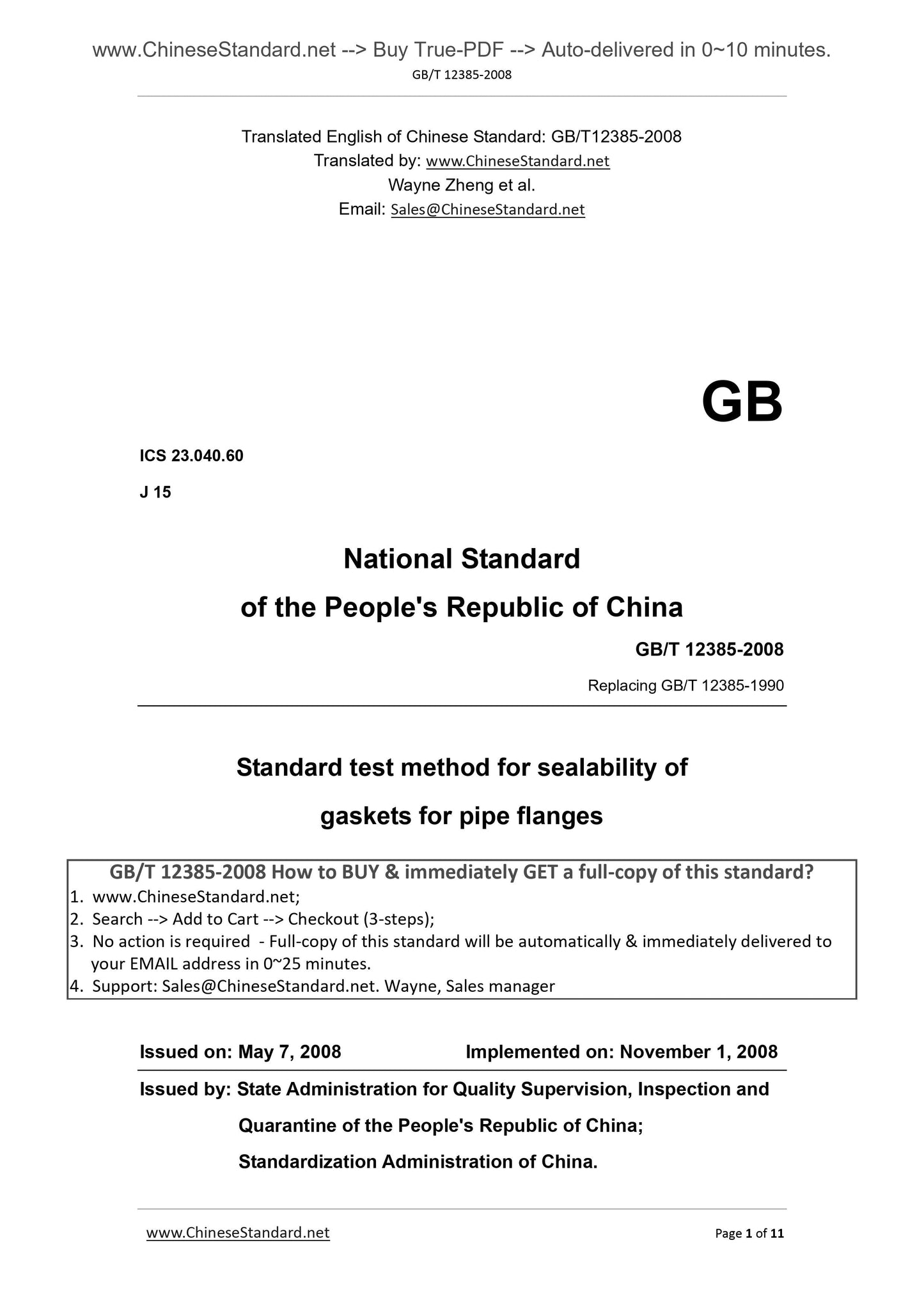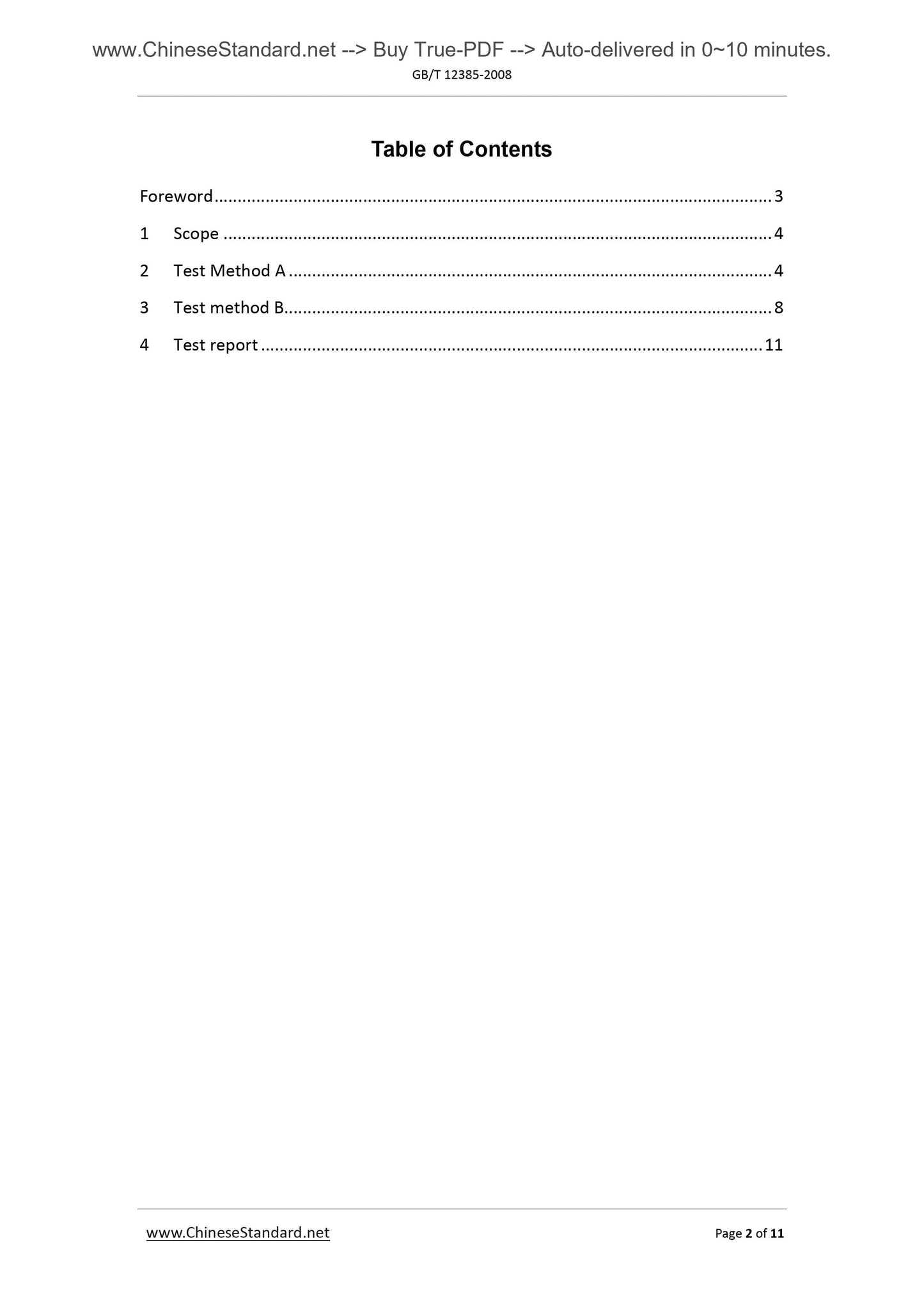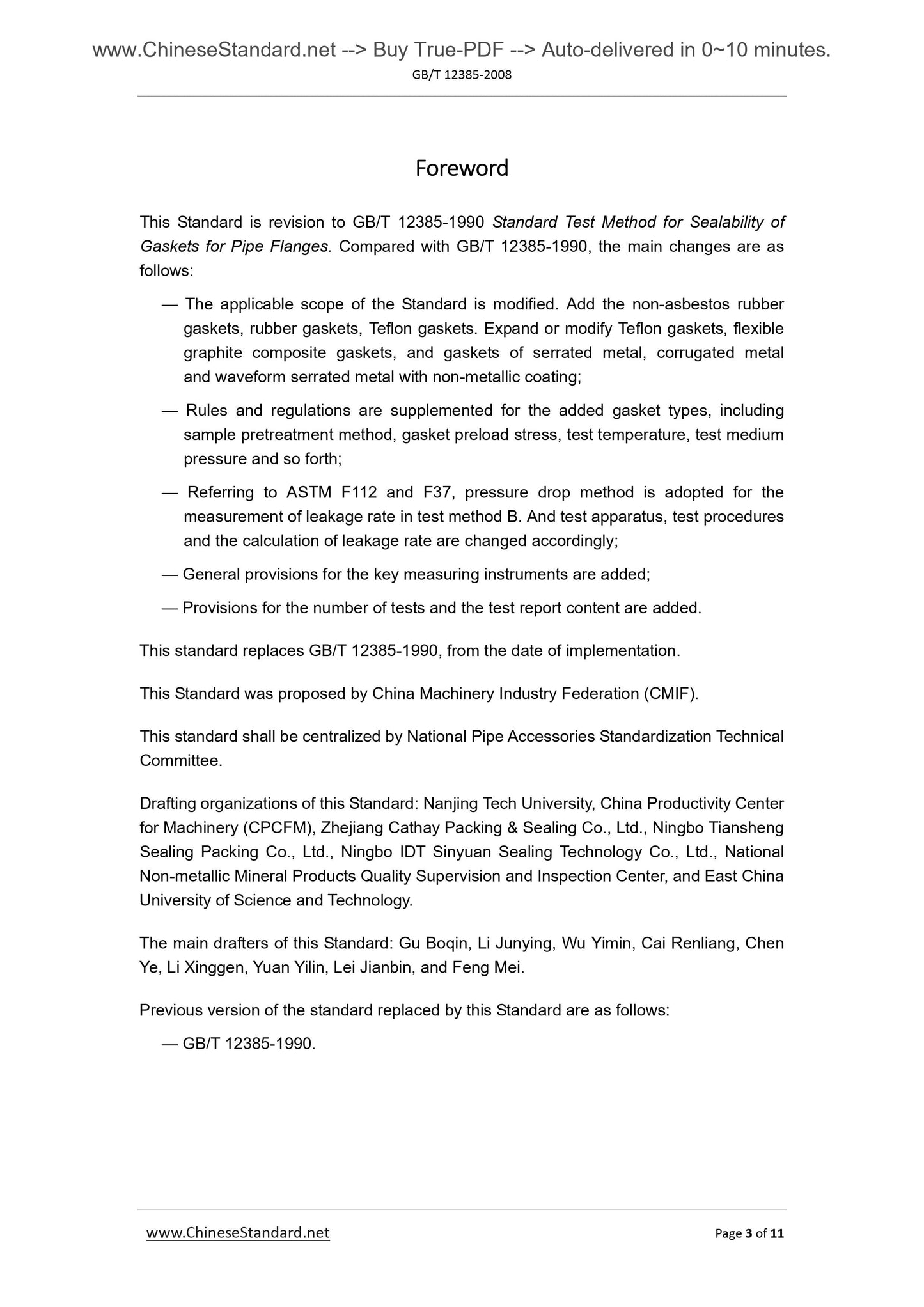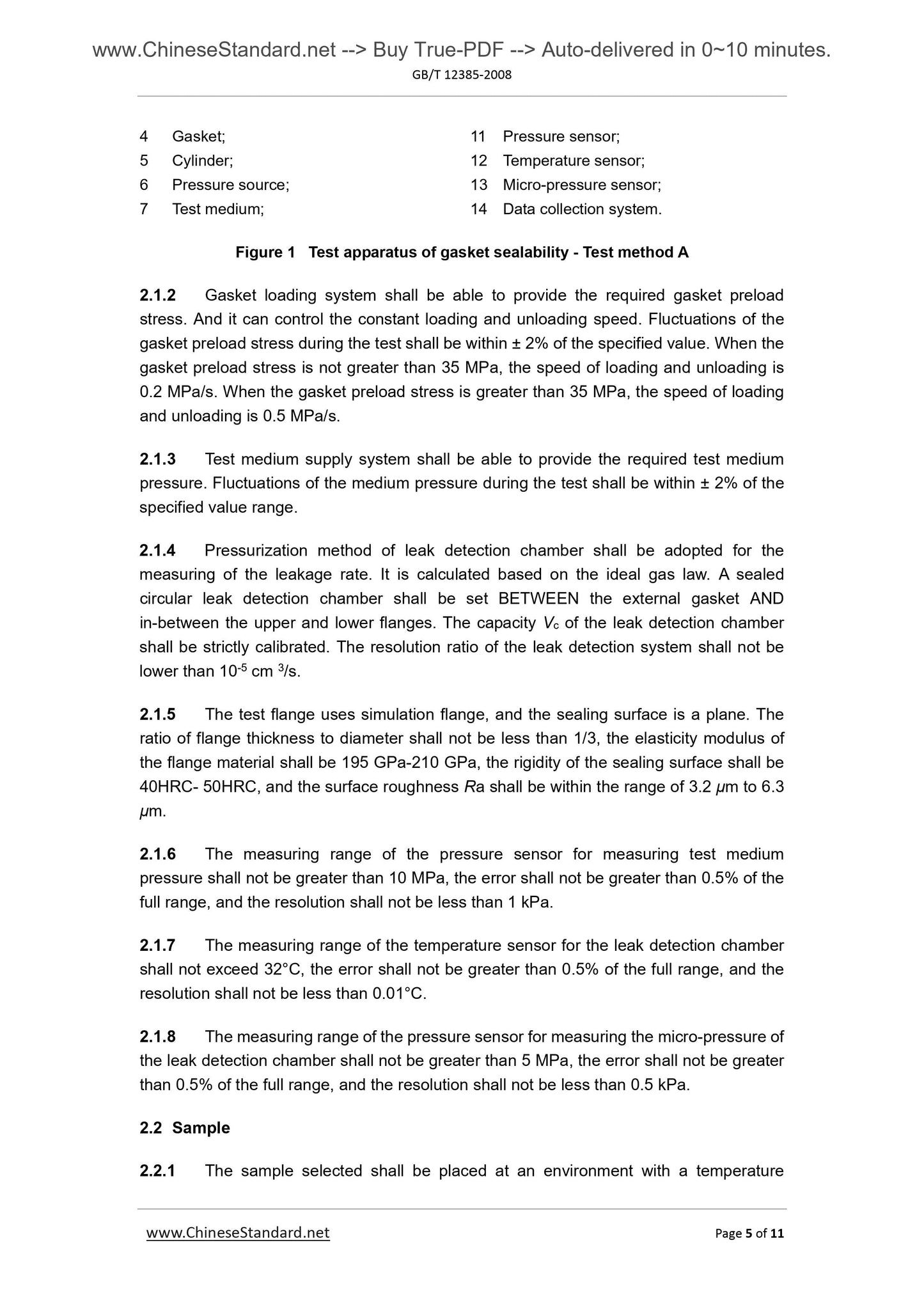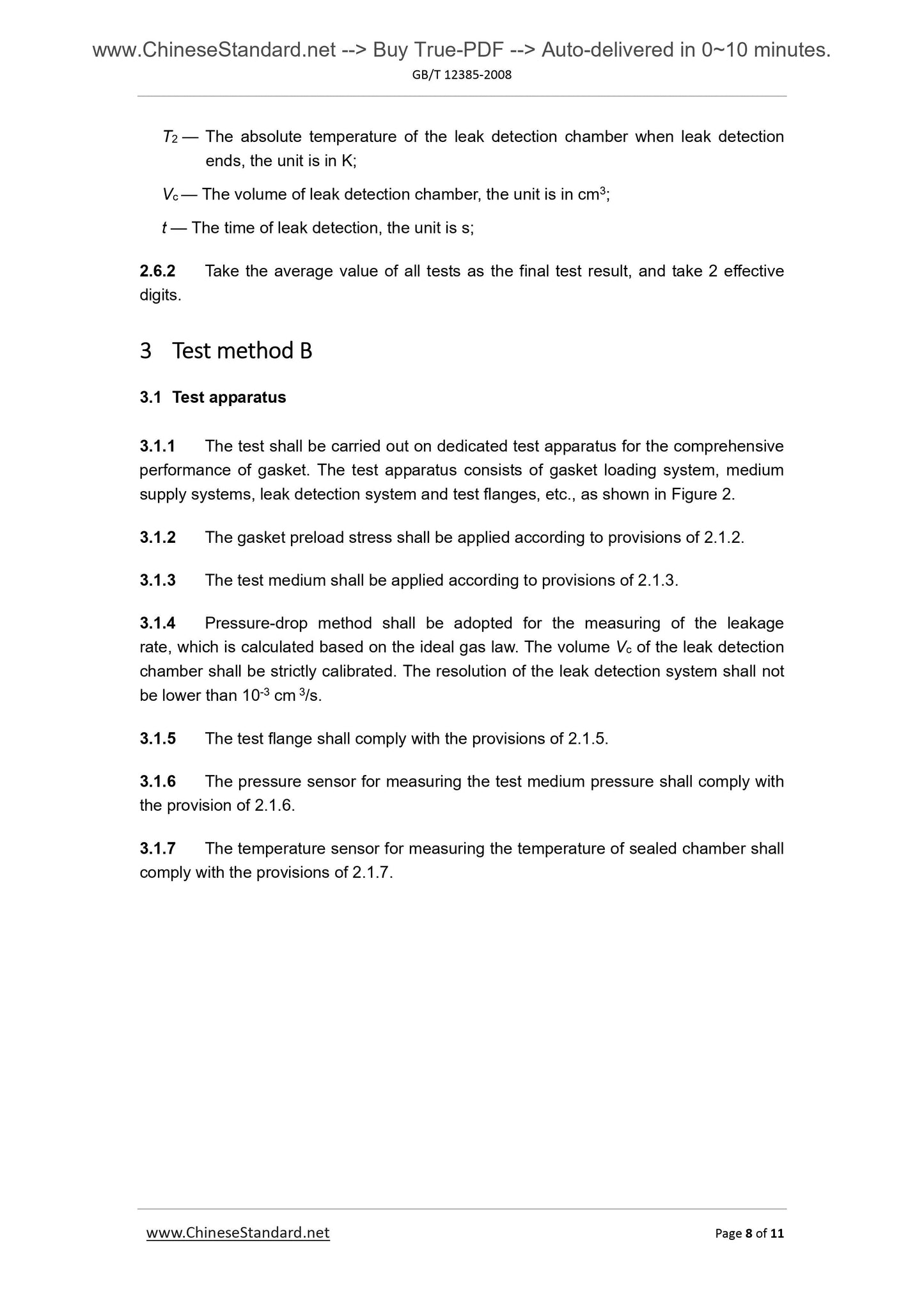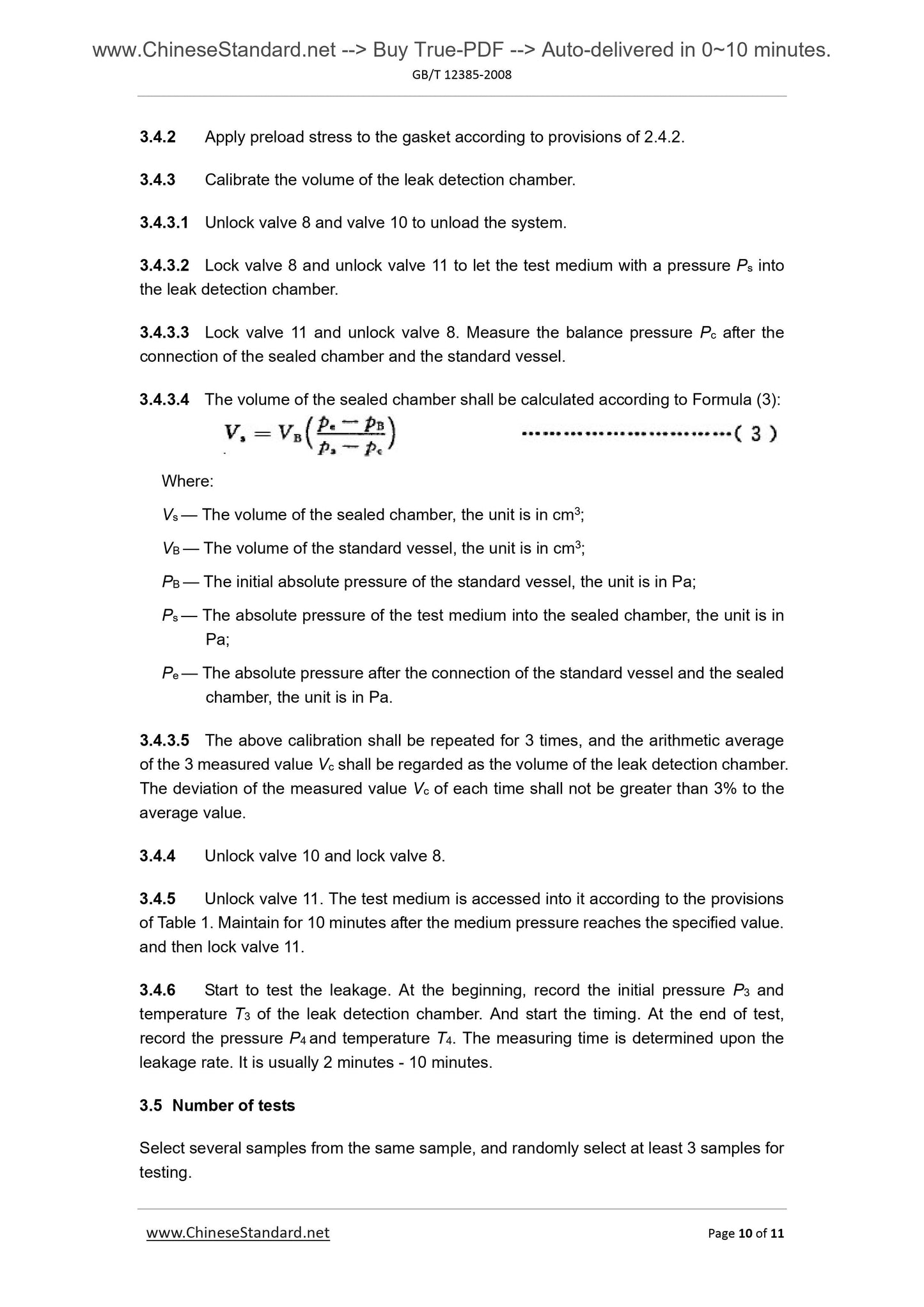1
/
of
6
PayPal, credit cards. Download editable-PDF and invoice in 1 second!
GB/T 12385-2008 English PDF (GBT12385-2008)
GB/T 12385-2008 English PDF (GBT12385-2008)
Regular price
$90.00 USD
Regular price
Sale price
$90.00 USD
Unit price
/
per
Shipping calculated at checkout.
Couldn't load pickup availability
Delivery: 3 seconds. Download true-PDF + Invoice.
Get QUOTATION in 1-minute: Click GB/T 12385-2008
Historical versions: GB/T 12385-2008
Preview True-PDF (Reload/Scroll if blank)
GB/T 12385-2008: Standard test method for sealability of gaskets for pipe flanges
GB/T 12385‐2008
GB
ICS 23.040.60
J 15
National Standard
of the People's Republic of China
Replacing GB/T 12385-1990
Standard test method for sealability of
gaskets for pipe flanges
ISSUED ON. MAY 7, 2008
IMPLEMENTED ON. NOVEMBER 1, 2008
Issued by. State Administration for Quality Supervision, Inspection and
Quarantine of the People's Republic of China;
Standardization Administration of China.
Table of Contents
Foreword ... 3
1 Scope ... 4
2 Test Method A ... 4
3 Test method B... 8
4 Test report ... 11
Foreword
This Standard is revision to GB/T 12385-1990 Standard Test Method for Sealability of
Gaskets for Pipe Flanges. Compared with GB/T 12385-1990, the main changes are as
follows.
— The applicable scope of the Standard is modified. Add the non-asbestos rubber
gaskets, rubber gaskets, Teflon gaskets. Expand or modify Teflon gaskets, flexible
graphite composite gaskets, and gaskets of serrated metal, corrugated metal
and waveform serrated metal with non-metallic coating;
— Rules and regulations are supplemented for the added gasket types, including
sample pretreatment method, gasket preload stress, test temperature, test medium
pressure and so forth;
— Referring to ASTM F112 and F37, pressure drop method is adopted for the
measurement of leakage rate in test method B. And test apparatus, test procedures
and the calculation of leakage rate are changed accordingly;
— General provisions for the key measuring instruments are added;
— Provisions for the number of tests and the test report content are added.
This standard replaces GB/T 12385-1990, from the date of implementation.
This Standard was proposed by China Machinery Industry Federation (CMIF).
This standard shall be centralized by National Pipe Accessories Standardization Technical
Committee.
Drafting organizations of this Standard. Nanjing Tech University, China Productivity Center
for Machinery (CPCFM), Zhejiang Cathay Packing and Sealing Co., Ltd., Ningbo Tiansheng
Sealing Packing Co., Ltd., Ningbo IDT Sinyuan Sealing Technology Co., Ltd., National
Non-metallic Mineral Products Quality Supervision and Inspection Center, and East China
University of Science and Technology.
The main drafters of this Standard. Gu Boqin, Li Junying, Wu Yimin, Cai Renliang, Chen
Ye, Li Xinggen, Yuan Yilin, Lei Jianbin, and Feng Mei.
Previous version of the standard replaced by this Standard are as follows.
— GB/T 12385-1990.
Standard test method for sealability of gaskets for pipe flanges
1 Scope
This Standard specifies 2 test methods, Method A and Method B, for the sealability of
gaskets for pipe flanges.
The 2 test methods of this Standard are applicable to asbestos rubber gaskets,
non-asbestos rubber gaskets, rubber gaskets, Teflon gaskets, expanded or modified
Teflon gasket, flexible graphite composite gaskets, spiral wound gaskets, metallic clad
gaskets, Teflon clad gaskets and gaskets of serrated metal, corrugated metal
and waveform serrated metal with non-metallic coating. They are also applicable to
metallic flat gaskets.
2 Test Method A
2.1 Test apparatus
2.1.1 The test shall be carried out on dedicated test apparatus for the comprehensive
performance of gasket. The test apparatus consists of gasket loading system, medium
supply system, leak detection system and test flanges, etc., as shown in Figure 1.
1 Standard vessel;
2 leak detection chamber;
3 Simulation flange;
8 calibration gas source;
9 Displacement sensor;
10 Load Sensor;
4 Gasket;
5 Cylinder;
6 Pressure source;
7 Test medium;
11 Pressure sensor;
12 Temperature sensor;
13 Micro-pressure sensor;
14 Data collection system.
Figure 1 Test apparatus of gasket sealability - Test method A
2.1.2 Gasket loading system shall be able to provide the required gasket preload
stress. And it can control the constant loading and unloading speed. Fluctuations of the
gasket preload stress during the test shall be within ± 2% of the specified value. When the
gasket preload stress is not greater than 35 MPa, the speed of loading and unloading is
0.2 MPa/s. When the gasket preload stress is greater than 35 MPa, the speed of loading
and unloading is 0.5 MPa/s.
2.1.3 Test medium supply system shall be able to provide the required test medium
pressure. Fluctuations of the medium pressure during the test shall be within ± 2% of the
specified value range.
2.1.4 Pressurization method of leak detection chamber shall be adopted for the
measuring of the leakage rate. It is calculated based on the ideal gas law. A sealed
circular leak detection chamber shall be set BETWEEN the external gasket AND
in-between the upper and lower flanges. The capacity Vc of the leak detection chamber
shall be strictly calibrated. The resolution ratio of the leak detection system shall not be
lower than 10-5 cm 3/s.
2.1.5 The test flange uses simulation flange, and the sealing surface is a plane. The
ratio of flange thickness to diameter shall not be less than 1/3, the elasticity modulus of
the flange material shall be 195 GPa-210 GPa, the rigidity of the sealing surface shall be
40HRC- 50HRC, and the surface roughness Ra shall be within the range of 3.2 μm to 6.3
μm.
2.1.6 The measuring range of the pressure sensor for measuring test medium
pressure shall not be greater than 10 MPa, the error shall not be greater than 0.5% of the
full range, and the resolution shall not be less than 1 kPa.
2.1.7 The measuring range of the temperature sensor for the leak detection chamber
shall not exceed 32°C, the error shall not be greater than 0.5% of the full range, and the
resolution shall not be less than 0.01°C.
2.1.8 The measuring range of the pressure sensor for measuring the micro-pressure of
the leak detection chamber shall not be greater than 5 MPa, the error shall not be greater
than 0.5% of the full range, and the resolution shall not be less than 0.5 kPa.
2.2 Sample
2.2.1 The sample selected shall be placed at an environment with a temperature
between 21°C and 30°C, and a relative humidity of (50±6) % for at least 48h.
2.2.2 Unless otherwise specified, nominal diameter of the sample is DN80 and
nominal pressure is not greater than PN50.
2.3 Test conditions
Unless otherwise specified, the test conditions shall be according to the provisions in
Table 1.
Table 1 Test conditions
Test sample name
Gasket
preload
stress MPa
Test
temperature °C Test medium
Test medium
pressure MPa
Asbestos rubber gasket 40
23±5
99.9% of
industrial
nitrogen
4.0
Non-asbestos rubber gasket,
Teflon gasket and modified Teflon
gasket
35 4.0
Expanded Teflon gasket 25 4.0
Rubber gaskets 7 1.0
Flexible graphite composite
gasket 35
1.1 times of
nominal
pressure
Serrated metal, corrugated metal
and waveform serrated metal
gaskets with non-metallic coating
1.1 times of
nominal
pressure
Metal coated pads 60
1.1 times of
nominal
pressure
Teflon coated pads 35
1.1 times of
nominal
pressure
spiral wound gasket 70
1.1 times of
nominal
pressure
2.4 Test procedures
2.4.1 Clean flange sealing surface with solvent (such as acetone) carefully and install
the gasket in the center.
2.4.2 According to the regulations of Table 1, apply preload stress to the gasket to
reach the specified value and then maintain for 15 minutes.
2...
Get QUOTATION in 1-minute: Click GB/T 12385-2008
Historical versions: GB/T 12385-2008
Preview True-PDF (Reload/Scroll if blank)
GB/T 12385-2008: Standard test method for sealability of gaskets for pipe flanges
GB/T 12385‐2008
GB
ICS 23.040.60
J 15
National Standard
of the People's Republic of China
Replacing GB/T 12385-1990
Standard test method for sealability of
gaskets for pipe flanges
ISSUED ON. MAY 7, 2008
IMPLEMENTED ON. NOVEMBER 1, 2008
Issued by. State Administration for Quality Supervision, Inspection and
Quarantine of the People's Republic of China;
Standardization Administration of China.
Table of Contents
Foreword ... 3
1 Scope ... 4
2 Test Method A ... 4
3 Test method B... 8
4 Test report ... 11
Foreword
This Standard is revision to GB/T 12385-1990 Standard Test Method for Sealability of
Gaskets for Pipe Flanges. Compared with GB/T 12385-1990, the main changes are as
follows.
— The applicable scope of the Standard is modified. Add the non-asbestos rubber
gaskets, rubber gaskets, Teflon gaskets. Expand or modify Teflon gaskets, flexible
graphite composite gaskets, and gaskets of serrated metal, corrugated metal
and waveform serrated metal with non-metallic coating;
— Rules and regulations are supplemented for the added gasket types, including
sample pretreatment method, gasket preload stress, test temperature, test medium
pressure and so forth;
— Referring to ASTM F112 and F37, pressure drop method is adopted for the
measurement of leakage rate in test method B. And test apparatus, test procedures
and the calculation of leakage rate are changed accordingly;
— General provisions for the key measuring instruments are added;
— Provisions for the number of tests and the test report content are added.
This standard replaces GB/T 12385-1990, from the date of implementation.
This Standard was proposed by China Machinery Industry Federation (CMIF).
This standard shall be centralized by National Pipe Accessories Standardization Technical
Committee.
Drafting organizations of this Standard. Nanjing Tech University, China Productivity Center
for Machinery (CPCFM), Zhejiang Cathay Packing and Sealing Co., Ltd., Ningbo Tiansheng
Sealing Packing Co., Ltd., Ningbo IDT Sinyuan Sealing Technology Co., Ltd., National
Non-metallic Mineral Products Quality Supervision and Inspection Center, and East China
University of Science and Technology.
The main drafters of this Standard. Gu Boqin, Li Junying, Wu Yimin, Cai Renliang, Chen
Ye, Li Xinggen, Yuan Yilin, Lei Jianbin, and Feng Mei.
Previous version of the standard replaced by this Standard are as follows.
— GB/T 12385-1990.
Standard test method for sealability of gaskets for pipe flanges
1 Scope
This Standard specifies 2 test methods, Method A and Method B, for the sealability of
gaskets for pipe flanges.
The 2 test methods of this Standard are applicable to asbestos rubber gaskets,
non-asbestos rubber gaskets, rubber gaskets, Teflon gaskets, expanded or modified
Teflon gasket, flexible graphite composite gaskets, spiral wound gaskets, metallic clad
gaskets, Teflon clad gaskets and gaskets of serrated metal, corrugated metal
and waveform serrated metal with non-metallic coating. They are also applicable to
metallic flat gaskets.
2 Test Method A
2.1 Test apparatus
2.1.1 The test shall be carried out on dedicated test apparatus for the comprehensive
performance of gasket. The test apparatus consists of gasket loading system, medium
supply system, leak detection system and test flanges, etc., as shown in Figure 1.
1 Standard vessel;
2 leak detection chamber;
3 Simulation flange;
8 calibration gas source;
9 Displacement sensor;
10 Load Sensor;
4 Gasket;
5 Cylinder;
6 Pressure source;
7 Test medium;
11 Pressure sensor;
12 Temperature sensor;
13 Micro-pressure sensor;
14 Data collection system.
Figure 1 Test apparatus of gasket sealability - Test method A
2.1.2 Gasket loading system shall be able to provide the required gasket preload
stress. And it can control the constant loading and unloading speed. Fluctuations of the
gasket preload stress during the test shall be within ± 2% of the specified value. When the
gasket preload stress is not greater than 35 MPa, the speed of loading and unloading is
0.2 MPa/s. When the gasket preload stress is greater than 35 MPa, the speed of loading
and unloading is 0.5 MPa/s.
2.1.3 Test medium supply system shall be able to provide the required test medium
pressure. Fluctuations of the medium pressure during the test shall be within ± 2% of the
specified value range.
2.1.4 Pressurization method of leak detection chamber shall be adopted for the
measuring of the leakage rate. It is calculated based on the ideal gas law. A sealed
circular leak detection chamber shall be set BETWEEN the external gasket AND
in-between the upper and lower flanges. The capacity Vc of the leak detection chamber
shall be strictly calibrated. The resolution ratio of the leak detection system shall not be
lower than 10-5 cm 3/s.
2.1.5 The test flange uses simulation flange, and the sealing surface is a plane. The
ratio of flange thickness to diameter shall not be less than 1/3, the elasticity modulus of
the flange material shall be 195 GPa-210 GPa, the rigidity of the sealing surface shall be
40HRC- 50HRC, and the surface roughness Ra shall be within the range of 3.2 μm to 6.3
μm.
2.1.6 The measuring range of the pressure sensor for measuring test medium
pressure shall not be greater than 10 MPa, the error shall not be greater than 0.5% of the
full range, and the resolution shall not be less than 1 kPa.
2.1.7 The measuring range of the temperature sensor for the leak detection chamber
shall not exceed 32°C, the error shall not be greater than 0.5% of the full range, and the
resolution shall not be less than 0.01°C.
2.1.8 The measuring range of the pressure sensor for measuring the micro-pressure of
the leak detection chamber shall not be greater than 5 MPa, the error shall not be greater
than 0.5% of the full range, and the resolution shall not be less than 0.5 kPa.
2.2 Sample
2.2.1 The sample selected shall be placed at an environment with a temperature
between 21°C and 30°C, and a relative humidity of (50±6) % for at least 48h.
2.2.2 Unless otherwise specified, nominal diameter of the sample is DN80 and
nominal pressure is not greater than PN50.
2.3 Test conditions
Unless otherwise specified, the test conditions shall be according to the provisions in
Table 1.
Table 1 Test conditions
Test sample name
Gasket
preload
stress MPa
Test
temperature °C Test medium
Test medium
pressure MPa
Asbestos rubber gasket 40
23±5
99.9% of
industrial
nitrogen
4.0
Non-asbestos rubber gasket,
Teflon gasket and modified Teflon
gasket
35 4.0
Expanded Teflon gasket 25 4.0
Rubber gaskets 7 1.0
Flexible graphite composite
gasket 35
1.1 times of
nominal
pressure
Serrated metal, corrugated metal
and waveform serrated metal
gaskets with non-metallic coating
1.1 times of
nominal
pressure
Metal coated pads 60
1.1 times of
nominal
pressure
Teflon coated pads 35
1.1 times of
nominal
pressure
spiral wound gasket 70
1.1 times of
nominal
pressure
2.4 Test procedures
2.4.1 Clean flange sealing surface with solvent (such as acetone) carefully and install
the gasket in the center.
2.4.2 According to the regulations of Table 1, apply preload stress to the gasket to
reach the specified value and then maintain for 15 minutes.
2...
Share
